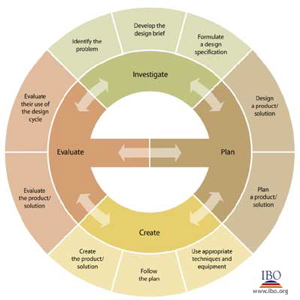In addition to middle school IT integration, I also teach discrete IT exploratory classes for all middle school students. These exploratories run for 9 weeks (1 quarter), and are intended to expose students to new ideas in a fun and relaxed way. Due to the nature of the class, we usually only manage one or two projects following the MYP Technology Design Cycle. I try to make the projects as fun as possible (don’t we all?) and I very rarely give homework. My sixth graders learn how to create movies using iMovie, seventh graders create personal logos in FreeHand, and eighth graders create e-cards using Flash. All classes finish by creating e-portfolios using Dreamweaver. Last year these projects took the entire 9 weeks. Going through the Design Cycle – Investigate, Plan, Create, Evaluate – is such a valuable process, and really helps clarify for the students how to design a successful technology project, but it takes some time.

Even with the time crunch, I knew I had to add a web 2.0 element to my classes this year and I am so happy with how well it turned out (and how little time it took). Just after the students finished creating their movies/logos/e-cards, I showed them my Middle School IT wikispace and gave a (very) short lesson on wikis. Their next project was to create a tutorial wiki on the software application we studied. I used the UbD GRASPS model to design the task, giving the students an authentic goal: an online tutorial, a real audience: first time users of this software anywhere in the world, and a realistic role: software developers at the appropriate company. As a class we developed the pages that needed to be created and decided on: introduction, skills/tools, finished products, tips, glossary and supporting external links. I asked the students to select a group based on their comfort level with the technology and personal interest and we were off! Each class took about 2-3 lessons (a total of 3 – 4.5 hours of class time) to complete their tutorial. Once all the groups were finished with their individual pages, we rotated through so that each group was able to review, revise and perfect every other groups work.
I am so impressed with how well they were able to complete the tutorials, how fast they were able to finish (compared to designing a site from scratch using Dreamweaver) and how much knowledge they were able to demonstrate within the structure of the project. Take a look if you’re interested:
I think the most exciting part for me, though, was the authentic collaboration that using wikis allowed and how easily students were able to focus on the content not the technology. I was genuinely concerned that I would not be able to add a third project into an already jam-packed course, but the simplicity of wikis made everything a breeze! The students were able to grasp the tech skills in about 10 minutes and the rest of the time was spent working, sharing, learning and collaborating. I am so impressed with how focused the students were, how easily they took to the task, and how well they worked together. Groups were set up loosely based on skill and ability level (and personal interest) which really helped keep each student engaged as they worked. Needless to say, this project is my new favorite part of the course!
Image from: http://www.myptechnology.com/sitefiles/DesignCycleQuestions.htm




